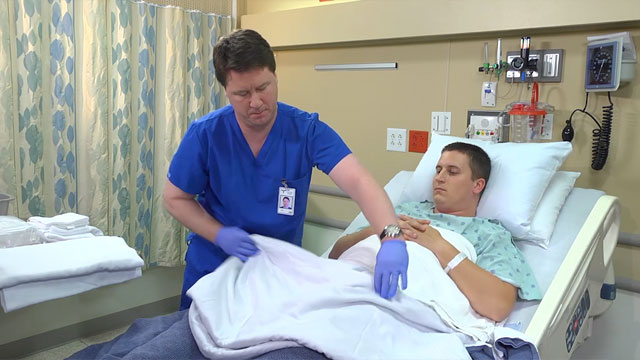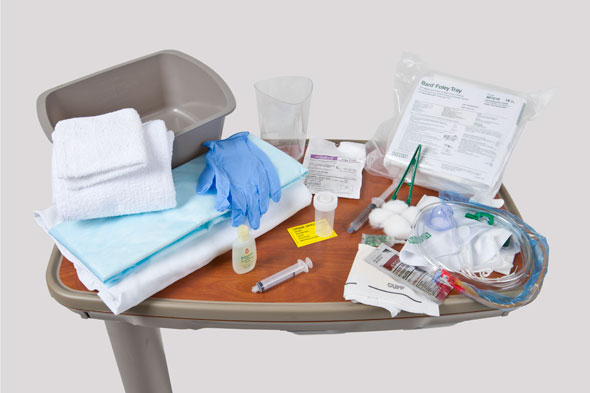Urinary Catheter Management
Select a Skill:
- » Inserting an Indwelling Urinary Catheter in a Female Patient
- » Inserting an Indwelling Urinary Catheter in a Male Patient
- » Irrigating a Urinary Catheter
- » Performing Intermittent Straight Catheterization
- » Obtaining a Specimen from an Indwelling Urinary Catheter
- » Removing an Indwelling Urinary Catheter
- » Caring for a Suprapubic Catheter
Take the Review Test:

Safety
- Use a nonlatex catheter if the patient is allergic to latex. Assess the patient for an allergy to the antiseptic, tape, and lubricant.
- Always carry or hang the bag below the level of the bladder, such as on the bed frame or a chair, so that urine will drain down, out of the bladder. Never allow the bag to touch the floor.
- If you feel resistance or the patient reports pain when advancing the catheter, DO NOT USE FORCE. Stop advancing the catheter. Ask the patient to take slow, deep breaths to promote relaxation. Hold the catheter gently in place without forcing it. After a few seconds, the sphincter may relax, and the catheter can be advanced.
- If the patient complains of sudden pain during inflation of a catheter balloon or if you feel resistance when inflating the balloon, stop inflating the balloon, allow the fluid from the balloon to flow back into the syringe, advance the catheter farther, and reinflate the balloon.
- Maintain sterile technique during catheterization.
Equipment
(Roll cursor over items to see labels)

Indwelling catheterization kit (contents may vary)
- Catheter
- Fenestrated drape
- Lubricant
- Cleansing solution
- Cotton Balls
- Forceps
- Sterile drainage tubing with collection bag
- Sterile gloves
Indwelling catheterization kit (contents may vary)
- Catheter
- Fenestrated drape
- Lubricant
- Cleansing solution
- Cotton Balls
- Forceps
- Sterile drainage tubing with collection bag
- Sterile gloves
Syringe
Sterile specimen container with label (optional)
Catheter securement device
Bath blanket
Waterproof pad
Clean gloves
Basin
Soap
Washcloth and towel
Measuring container for urine
Delegation
The skill of inserting an indwelling urinary catheter cannot be delegated to nursing assistive personnel (NAP). Be sure to inform NAP of the following:
- Explain how to assist with patient positioning, focus lighting for the procedure, maintain privacy, empty urine from the collection bag, and assist with perineal care.
- Instruct NAP to report postprocedure patient discomfort or fever.
- Instruct NAP to report abnormal urine color, odor, or amount, or if the catheter is leaking or causing pain.
Preparation
- Review the patient’s medical record, including the health care provider’s order and nurses’ notes. Note previous catheterizations, including catheter size, response of patient, time of catheterization, and any pathological condition that may impair the passage of the catheter, such as an enlarged prostate gland.
- Ask the patient and check the patient’s medical record for allergies.
- Assess the patient’s gender, age, weight, level of consciousness, developmental level, ability to cooperate, and mobility, his knowledge of and prior experience with catheterization, and his feelings about the procedure.
- Assess for pain and bladder fullness. Palpate the bladder over the symphysis pubis, or use a bladder scanner (if available).
- Perform hand hygiene, and apply gloves. Inspect the perineal region, observing for perineal anatomical landmarks, erythema, drainage or discharge, and odor. Remove gloves, and perform hand hygiene.
- Explain the procedure to the patient.
- Arrange for extra personnel to assist as necessary.
Follow-up
- Palpate the patient’s bladder for distention, or use a bladder scan.
- Ask the patient to describe his level of comfort.
- Observe the character and amount of urine in the drainage system.
- Determine that there is no urine leaking from the catheter or tubing connections.
Documentation
- Record and report the reason for the catheterization; the type and size of the catheter inserted; the amount of fluid used to inflate the balloon; specimen collection (if applicable); characteristics of the urine; amount of urine; and the patient’s response to the procedure, as well as any education provided to him.
- Record the amount of urine on the intake and output (I&O) flow sheet record.
- Report any persistent catheter-related pain and discomfort to the health care provider.
Review Questions
1. What is the best reason for the nurse to instruct a male patient to take slow, deep breaths during insertion of an indwelling urinary catheter?
2. When preparing to insert an indwelling urinary catheter in a male patient, it is important for the nurse to do what?
 Remove the cotton balls from the kit for later use.
Remove the cotton balls from the kit for later use. Advance the catheter 10 to 12 inches or until urine flows.
Advance the catheter 10 to 12 inches or until urine flows. Lubricate the first 5 to 7 inches of the catheter.
Lubricate the first 5 to 7 inches of the catheter. Hold the penis at a 45-degree angle during insertion.
Hold the penis at a 45-degree angle during insertion.
3. Which observation indicates that instruction given to nursing assistive personnel (NAP) in caring for a patient with an indwelling urinary catheter has been effective?
 The collection bag has been placed on the side rail of the bed.
The collection bag has been placed on the side rail of the bed. The excess catheter tubing has been coiled beside the patient’s inner thigh.
The excess catheter tubing has been coiled beside the patient’s inner thigh. The collection bag has been placed on the bed.
The collection bag has been placed on the bed. The collection bag is held above the level of the bladder while ambulating the patient.
The collection bag is held above the level of the bladder while ambulating the patient.
4. Which action will the nurse implement to reduce the risk of catheter-associated urinary tract infection (CAUTI) in a male patient with an indwelling urinary catheter?
 Frequently pull on the drainage system tubing.
Frequently pull on the drainage system tubing. Use the largest-size catheter possible.
Use the largest-size catheter possible. Clean the urinary meatus daily.
Clean the urinary meatus daily. Apply antiseptics to the urinary meatus.
Apply antiseptics to the urinary meatus.
5. While setting up the sterile field in preparation for inserting an indwelling urinary catheter, a male patient is incontinent of urine over most of the supplies. What action would the nurse take to reduce the patient’s risk for infection?
 Rinse off the supplies that were contaminated with urine.
Rinse off the supplies that were contaminated with urine. Cleanse the patient’s urinary meatus.
Cleanse the patient’s urinary meatus. Replace all contaminated supplies, and begin the process again.
Replace all contaminated supplies, and begin the process again. Change the patient’s bed linens.
Change the patient’s bed linens.
You have completed the Review Questions for this skill. To take the Review again select the Start Over button. To proceed to another skill select from the dropdown menu. Select the Home or Back button to proceed to the next section.

